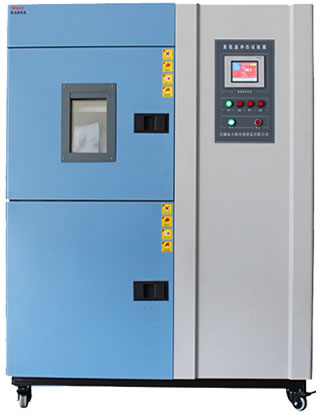What is Thermal Shock Testing or Temperature Cycle Testing?
Both thermal shock testing and temperature cycle testing exposes a device under test (DUT) to alternating high and low air temperatures to accelerate failures caused due to repeated temperature variations during normal use conditions.
The transition between temperature extremes occurs very rapidly during thermal shock test, higher than 15 °C per minute. Alternatively, temperature cycle testing uses slower rates of change between high and low temperatures.

Equipment with single or multiple chambers can be utilized in performing thermal shock testing. While using single chamber thermal shock equipment, the DUT or samples will be in one chamber and the chamber air temperature is rapidly cooled and heated. This usually produces a slower rate of change in the product response temperature mainly because the entire chamber will have to be cooled down and heated up.
However larger DUT can possibly be tested in single compartment chambers. Some equipment uses separate hot and cold chambers with an elevator mechanism that transports the device under test between two or more chambers. This leads to a more rapid rate of change in the air temperature. However, there is restriction on the size and weight that can be placed inside a chamber using an elevator mechanism.
When performing thermal shock testing, the upper and lower temperatures needs to be carefully determined. Larger differences between the test chamber temperatures and the device under test normal use temperatures will result in higher acceleration factors as determined by Coffin-Mason equation. However, an appropriate temperature limits is required to be selected to not exceed the operating limits or material property limits of the device under test.
For example, an upper temperature that exceeds the melting point of any material in the product would likely bring about invalid test failures. For this reason, it is crucial that these temperatures be properly measured and monitored in the course of the test through careful placement of thermocouples on and around the or samples.
Factors that can influence the test parameters comprise of the thermal mass of the device under test, the number of and the airflow around the device under test that depends on the DUT spacing within the chamber. The dwell time at each and every temperature are required to be included in the test specification in addition to tolerances around the high and low temperatures. Test methods can also specify minimum rates of temperature change.
The DUT could either be powered or unpowered during thermal shock testing. DUT that are powered during the test need harnesses that are long enough to reach from outside of the chamber and through the chamber feed-through ports.
Examples of some common thermal shock test specifications includes: MIL-STD-202, Method 107, Thermal Shock MIL-STD 810, Method 503, Temperature Shock MIL-STD-883, Method 1010, Temperature Cycling JESD22-A104D, Temperature Cycling
Paragon Systems Testing is a highly experienced thermal shock testing lab where we assist our customers in setting up a test using the proper test conditions. So, if you do not know what test conditions that you should use or what specification to choose, then we will help you because we are thermal shock testing experts!



